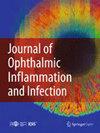活体共聚焦显微镜在疑似阿卡阿米巴角膜炎中的应用:瑞典地区转诊中心 12 年真实数据研究
IF 2.9
Q1 OPHTHALMOLOGY
Journal of Ophthalmic Inflammation and Infection
Pub Date : 2024-09-10
DOI:10.1186/s12348-024-00424-y
引用次数: 0
摘要
报告一个地区转诊中心在 12 年间使用体内共聚焦显微镜 (IVCM) 处理疑似阿卡阿米巴角膜炎 (AK) 病例的真实世界数据 (RWD)。该研究对 2010 年至 2022 年期间在瑞典一家地区转诊中心接受 IVCM 检查的疑似 AK 患者进行了回顾性研究。研究人员分析了患者的人口统计学特征、症状、结果和临床治疗,并对 IVCM 图像进行了解读。在纳入的 74 例疑似 AK 患者中,18 例(24%)为 IVCM 阳性,33 例(44%)为 IVCM 阴性,15 例 IVCM 结果不确定(20.2%),8 例(11%)根据 IVCM 转诊至第二诊疗中心,其中 4 例为 IVCM 阳性(5.5%),总的 IVCM 阳性率为 29.5%。对 38 例病例(51%)进行了培养,只有 2 例(2.7%)培养呈 AK 阳性。在 IVCM 阴性病例中,22 例(67%)进行了培养,其中 100%为 AK 阴性。与 IVCM 阴性患者相比,IVCM 阳性患者的就诊次数更多(中位数为 30 次,P = 0.018),随访时间更长(中位数为 890 天,P = 0.009),而视力改善情况则没有差异(P > 0.05)。在 IVCM 阳性病例中,10 例(56%)患者在接受抗阿米巴治疗后仍接受了手术,14 例(78%)患者在随访期间接受了 3 次或更多次 IVCM 检查,其中囊肿(100%)、树突状细胞(89%)和炎症浸润(67%)是最常见的特征。纵向 IVCM 显示,随着治疗的进行,囊肿、树突状细胞和基底膜下神经的情况有所改善,而临床症状的缓解并不总是与囊肿完全消失一致。在现实世界中,IVCM 对 AK 阴性病例的分类具有很高的可靠性,而与黄金标准培养法相比,IVCM 能更频繁地检测到 AK 阳性病例,因此,在时间或资源有限的情况下,IVCM 比培养法更受青睐。尽管如此,仍有一部分病例 IVCM 无法得出结论,转诊患者的临床病程较长,需要多次到医院就诊,而且大多数病例仅靠药物治疗无法改善视力。为了充分发挥 IVCM 在 AK 患者管理方面的潜力,需要在各中心之间共享信息,并规范转诊和诊断程序。本文章由计算机程序翻译,如有差异,请以英文原文为准。
Use of in vivo confocal microscopy in suspected Acanthamoeba keratitis: a 12-year real-world data study at a Swedish regional referral center
To report real-world data (RWD) on the use of in vivo confocal microscopy (IVCM) in handling cases of suspected Acanthamoeba keratitis (AK) cases at a regional referral center during a 12-year period. Retrospective study of patients with suspected AK presenting at a regional referral center for IVCM in Sweden from 2010 to 2022. Demographics, symptoms, outcomes, and clinical management were analyzed, and IVCM images were interpreted. Of 74 included patients with suspected AK, 18 (24%) were IVCM-positive, 33 (44%) were IVCM-negative, 15 had inconclusive IVCM results (20.2%), and 8 (11%) were referred for a second opinion based on IVCM, 4 of which were IVCM-positive (5.5%), yielding an overall IVCM-positive rate of 29.5%. Cultures were taken in 38 cases (51%) with only 2 cases (2.7%) culture-positive for AK. Of IVCM-negative cases, cultures were taken in 22 (67%) of cases and 100% of these were AK-negative. IVCM-positive cases had more clinic visits (median 30, P = 0.018) and longer follow-up time (median 890 days, P = 0.009) than IVCM-negative patients, while visual acuity improvement did not differ (P > 0.05). Of IVCM-positive cases, 10 (56%) underwent surgery despite prior anti-amoebic treatment, and 14 (78%) had 3 or more IVCM examinations during follow-up, with cysts (100%), dendritic cells (89%) and inflammatory infiltrate (67%) as the most prevalent features. Longitudinal IVCM indicated improvement in cysts, dendritic cells and subbasal nerves with treatment, while clinical resolution was not always consistent with complete absence of cysts. In a real-world setting, IVCM has a high reliability in classifying AK-negative cases, while IVCM detects AK-positive cases more frequently than the gold-standard culture method, leading to its preferential use over the culture method where time or resources are limited. Despite this, a subset of cases are IVCM-inconclusive, the clinical course of referred patients is long requiring many hospital visits, and visual acuity in most cases does not improve with medical treatment alone. Information sharing across centers and standardization of referral and diagnostic routines is needed to exploit the full potential of IVCM in AK patient management.
求助全文
通过发布文献求助,成功后即可免费获取论文全文。
去求助
来源期刊

Journal of Ophthalmic Inflammation and Infection
OPHTHALMOLOGY-
CiteScore
3.80
自引率
3.40%
发文量
39
审稿时长
13 weeks
 求助内容:
求助内容: 应助结果提醒方式:
应助结果提醒方式:


